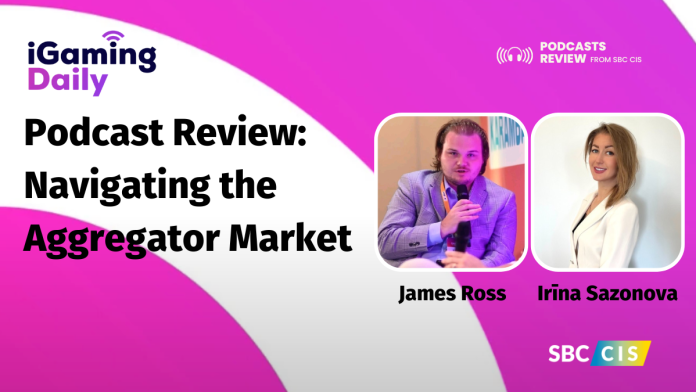Working with aggregators can give users access to thousands of titles that otherwise would require individual integration. However, in recent times, the market has witnessed an influx in aggregators and the question circulating the sector is – have we now reached an overload of supply?
Irīna Sazonova from EveryMatrix joined James Ross as a guest of the latest iGaming Daily podcast to talk about the climate of opportunity for aggregator operator partnerships, and how this could be better leveraged in the future.
Answering the main question of whether the aggregation market is oversaturated, Sazonova answers positively. It has become the preferred avenue for numerous top-tier operators, as well as studios across various jurisdictions. Additionally, it serves as the quickest route for many studios to expedite their content distribution strategies. Thus, there are numerous advantages to leveraging aggregation, and this trend is being strongly driven by both operators and players alike.
“I would say that there is much more to aggregation than simply aggregating the content. It should be a unified experience and offering, providing legal compliance, product, and other types of consultancy and data-driven insights into what is working and what isn’t working and where best to optimize. Plus, of course, it’s flexibility across various content and gamification functionality and additional innovation features that enhance revenue or create new revenue streams and boost acquisition and retention.”
She also mentioned that in recent times, aggregation has witnessed a significant upsurge, driven by the increasing demand from players for a broader range of choices. This trend can be attributed to two key factors. Firstly, the widespread adoption of mobile devices over the past decade or more has made it easier for people to access the internet and seek out their interests, including online gaming. Secondly, advancements in technology have made it more feasible to develop innovative games, leading to a surge in creative new ideas from emerging talents in the industry. This influx of fresh content has been well-received by players, contributing to the growing demand for diverse gaming experiences.
“As a result, when you have growing demand, you grow your offering as well. And to keep the pace, you need someone fast and scalable to help you both sides. Well, this is where the aggregator comes in.”
However, the aggregator cannot guarantee the slot’s success. The product itself determines everything.
“Aggregators just allow rising star studios and their innovations to proliferate in the market using their established networks where they can basically spread content far and wide. That doesn’t mean that studios do not need to market and push their content. The success of the slot launch depends not on the aggregator, but on the slot itself and how it will be welcomed by the players. So an aggregator would just increase chances of success by increasing the distribution and will help it to reach a wider audience.”
The increasing market saturation of aggregators has brought about a positive shift in the industry’s focus towards smaller studios. This trend is seen as a pathway to innovation, as smaller studios tend to have more creative freedom and flexibility. Collaborating with smaller studios allows aggregators to expose their products to a broader audience through major operators.
However, to make the most of this opportunity, Sazonova believes that small studios should carefully choose their aggregation partners, considering factors like scalability, technical capacity, adaptability to regulatory changes, market coverage, communication with operators, gamification tools, and various commercial models. By paying attention to these aspects, small studios can effectively leverage aggregators to promote their games in the industry.
Don’t forget to subscribe to our Telegram-channel!










